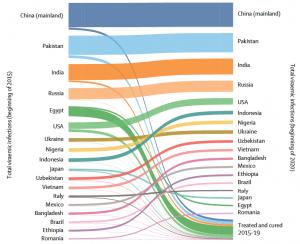Decline in hepatitis C infections globally is encouraging but still not enough
Important study of hepatitis data collected and interpreted by more than 250 collaborators published today by The Lancet Gastroenterology and Hepatology
This seminal work establishes a new baseline for the current burden of hepatitis C and it was only possible through contributions from national experts”
LAFAYETTE, CO, USA, February 15, 2022 /EINPresswire.com/ -- Global hepatitis C virus (HCV) infections declined by nearly 7 million between 2015 and 2020, but the number of infections is still estimated to exceed 56 million, according to an extensive study coordinated by the Center for Disease Analysis Foundation, which was published today in The Lancet Gastroenterology and Hepatology. “Global change in hepatitis C virus prevalence and cascade of care between 2015 and 2020” is authored by 258 members of the Polaris Observatory HCV Collaborators group, in partnership with the foundation. — Sarah Blach
The study provides an update on the prevalence of HCV in 235 countries and the burden it presents on these global communities. It examines HCV prevalence, cascade of care (including diagnosis and treatment) as well as forecasts for new infections, end stage outcomes, and deaths. The new direct acting antivirals (DAAs) therapies, which can cure HCV infections in a few weeks with nearly no side effects, have been used by an estimated 10.1 million infected people since 2015.
Despite the encouraging decline, the number of infections that remain suggests, per the model forecast, that the world is not on track to achieve elimination targets set by the World Health Assembly for 2030. Less than 10 years remain to meet this goal, which will require substantial effort.
Hepatitis C is the third leading cause of cancer deaths globally, and individuals infected with the HCV are 20 times more likely to develop liver cancer. As decision makers evaluate their HCV elimination efforts and progress following the COVID-19 pandemic, this study provides an updated baseline for future activities.
“This seminal work establishes a new baseline for the current burden of hepatitis C and it was only possible through contributions from national experts” said study author Sarah Blach. “More work is needed to eliminate HCV, but a growing number of success stories across countries, regions and income groups suggest there is still hope for elimination.”
CDA Foundation is a nonprofit organization focused on accelerating hepatitis B and C elimination through verified epidemiological data, disease burden and economic impact modeling, intervention strategies, access to affordable diagnostics and treatments, innovative financing and knowledge-sharing partnerships. It accomplishes these goals through two initiatives: the Polaris Observatory (https://cdafound.org/polaris/) and the Global Procurement Fund (https://cdafound.org/gpro/). For more information about this work or the Polaris Observatory, please contact Homie Razavi, info@cdafound.org
Link to the full study
Homie Razavi
CDA Foundation
+1 720-890-4848
email us here
Visit us on social media:
Twitter

